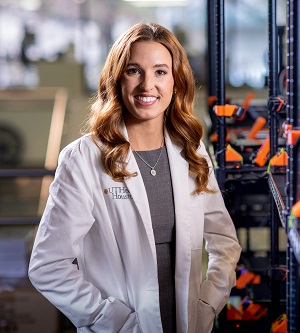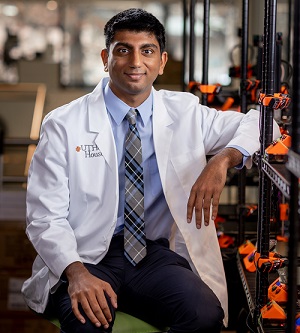
Engineering the future of health care
A partnership to advance innovative programs
Engineers construct marvels of civilization: They build bridges to connect distant communities, erect skyscrapers that breach the horizon, and develop the energy grids that power humankind. They also play a vital role in safeguarding the health of our communities and pushing the boundaries of biomedical science.
Bioengineers specialize in solving challenging health issues—from rapidly developing vaccines that protect against COVID-19 to manufacturing nanoparticles that target specific cancer cells.
“Solving problems is what makes me tick,” says Greg Zhang, who will become the first graduate of the joint MD/Master of Bioengineering (MBE) program through McGovern Medical School at UTHealth Houston and Rice University. “The MD/MBE program is a unique opportunity for me to merge my passions and bridge the gap between engineers and physicians to improve lives."
The MD/MBE program harnesses the creativity and ingenuity of two of Houston’s leading institutions to prepare future health professionals like Greg with the skills to develop solutions to urgent health needs and improve patient care.
Students in the MD/MBE program follow a condensed five-year academic path that enables them to simultaneously earn an MD from McGovern Medical School and an MBE from Rice. After spending their first three years in medical school, students complete the one-year MBE degree at Rice before completing their final year of medical school.
“The clinical knowledge I gained during the first three years of medical school gave me a unique perspective entering the MBE portion of the program,” says Greg. “My Rice classmates used their engineering backgrounds to guide discussions on product development and engineering principles, and I shared my clinical experiences to help my classmates understand the unique needs of physicians and patients.”
According to Allison Ownby, PhD, Associate Professor and Associate Dean of Educational Programs at McGovern Medical School, this exchange of knowledge between engineering and medical students forms the heart of the program. “While our medical students bring knowledge about specific health care issues and clinical experiences to the program, engineering students bring the skills to develop technologies,” she says. “By combining these strengths in the same classrooms, we can offer unparalleled experiences.”
During the MBE curriculum, students create real solutions that make a tangible impact on patients by working on bioengineering projects proposed by faculty and health professionals from across the Texas Medical Center. In one of the program’s core courses, students assemble in teams and select a project that interests them. From there, students transform into CEOs and generate a model to bring the product from idea to market.
Greg’s team set out to create a low-cost bag valve mask ventilator for children called the MiniVent, which could provide emergency ventilation to patients with severe breathing issues without the need to manually squeeze the bag.
“The MiniVent is essentially a box with two motors to automatically squeeze the bag valve mask for consistent ventilation over extended periods of time,” says Greg. “We also installed sensors that allow health providers to monitor ventilation.”
As COVID-19 continues to fill emergency rooms around the world with people suffering from breathing issues, the MiniVent could make lifesaving care more accessible to patients, no matter where they are.
“In addition to designing the MiniVent, we also outlined the steps to bring it to market, which included obtaining patents, meeting government regulations, and securing funding,” says Greg. “Students in future MBE cohorts will pick up the project where we left off and continue to refine it, taking the steps to eventually make the product available to health providers.”
Now in his final year of medical school, Greg plans to carry his experiences in the MD/MBE program into his future career as a surgeon.
“By combining my skills as a surgeon with my knowledge of bioengineering, I’ll be able to make a bigger impact on the health of my patients,” he says. “I hope to create new devices that will make surgeries more effective.”
Since Greg completed the MBE portion of the program in May 2021, two additional medical students began their MBE studies in fall 2021: Abby Louis and Neel Mutyala.

Interested in improving the health of underserved populations, Abby Louis joined the MD/MBE program to learn how to navigate government regulations to bring medical devices to patients in need around the world. In her MBE coursework, she is helping to develop a device that can stabilize the fetus during fetoscopic spina bifida repair—a delicate procedure before birth to correct a defect that occurs when the spine does not properly close.
“My education through the MD/MBE program would not be possible without the generous support of donors,” Abby says. “The scholarship I received not only benefits me, it benefits the lives of the patients I will touch through my care and the ideas I develop using my bioengineering experience.”

Neel Mutyala joined the MD/MBE program after seeing the potential for technology to improve patient outcomes during his clinical rotations at McGovern Medical School. In his MBE coursework, he is helping develop a device to improve the outcomes of children with hydrocephalus, a condition characterized by the buildup of cerebrospinal fluid in the brain. The device monitors pressure in the brain and allows health providers to drain excess fluid.
“Medical school is a large financial commitment, and the extra year of the MD/MBE program only adds to that,” Neel says. “Donors who have supported scholarships to the program are enabling me to become the best physician I can be for my future patients.”
“Our vision is to continue expanding the MD/MBE program to offer more opportunities for students,” says Gang Bao, PhD, Chair of the Department of Bioengineering at Rice University. “Building off its success, we hope to grow additional collaborations, including joint research programs that leverage the strengths of the extraordinary faculty at both institutions.”
Just as the MD/MBE program has enabled Greg, Abby, and Neel to learn how to engineer solutions to pressing health problems, donors have engineered unique opportunities for them to succeed. Since the Many Faces. One Mission. campaign launched, generous commitments from UTHealth Houston Development Board members Carolyn Frost Keenan, Barbara J. Gibbs, and Barry M. Lewis have supported scholarships for students in the MD/MBE program.
As the program continues to grow, and the partnership between UTHealth Houston and Rice University strengthens, new opportunities for students and additional collaborative programs will flourish.
In one collaboration, Sandipan Pati, MD, Associate Professor and neurologist with McGovern Medical School and UTHealth Houston Neurosciences, and John P. Seymour, PhD, Associate Professor in neurosurgery at McGovern Medical School and Adjunct Associate Professor at Rice University, are developing a device that could improve the diagnosis of epilepsy.
“Like going into a bustling stadium and trying to listen for one specific conversation amid the commotion, diagnostic tools for epilepsy help neurologists listen in the brain to learn where seizures are coming from,” says Seymour. “We’re engineering a device that will allow physicians to pinpoint where seizures originate with greater precision by amplifying the signal and reducing a significant amount of biological noise.”
During stereoelectroencephalography, a common diagnostic procedure for epilepsy, doctors implant small devices called depth electrodes in the brain, which measure brain activity to help locate seizures. Pati and Seymour are redesigning these depth electrodes to make them more accurate, which could allow doctors to make fewer implants while still collecting a more precise reading of the brain. Their efforts earned a two-year seed grant to help advance the project toward clinical trials.
“Through our affiliations with the Texas Institute of Restorative Neurotechnologies at UTHealth Houston and the Neuroengineering Initiative at Rice University, we have access to the brightest minds, the most advanced technologies, and the most innovative ideas that both institutions offer,” explains Seymour, who received a seed grant from the Barbara J. Gibbs Partnership Fund for a separate collaborative project. “Philanthropy provides critical seed funding that enables us to leverage that environment and pursue novel projects to collect the evidence required to earn larger federal grants.”
With new frontiers in health science and engineering waiting to be explored, UTHealth Houston and Rice University are primed for discovery.

“As health challenges around the world continue to evolve, our communities need physician-scientists who make exceptional patient care more accessible and more effective," says LaTanya J. Love, Dean of Education ad interim at UTHealth Houston. "Collaborations like these and the donors who support them empower us to capitalize on the innovative environment and one-of-a-kind institutions of the Texas Medical Center to train this new generation of health professionals.”

